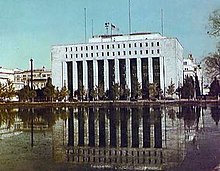Far East Command (United States)
| Far East Command (FECOM) | |
|---|---|

|
|
| Active | 1 January 1947 – 1 July 1957 |
| Country | United States |
| Type | Unified Combatant Command |
| Headquarters | Dai Ichi Building, Tokyo, Japan (1947 - 1952) Pershing Heights, Tokyo, Japan (1952 - 1957) |
| Engagements | Korean War |
| Commanders | |
| Notable commanders |
Douglas MacArthur Matthew B. Ridgway Mark W. Clark |
Far East Command (FECOM) was a United States military command from 1947 until 1957, functionally organised to undertake the occupation of Japan. It was created on January 1, 1947, and abolished, with functions transferred to Pacific Command, effective July 1, 1957, pursuant to Joint Chiefs of Staff (JCS) 1259/378. From 1947-51 it was commanded by General Douglas MacArthur, who was then succeeded by Generals Matthew Ridgeway and Mark Clark. Later commanders were Generals John E. Hull, Maxwell D. Taylor, and finally Lyman Lemnitzer.
Its initial army forces in 1947 comprised Eighth Army, XXIV Corps/U.S. Army Forces in Korea, and the Ryukyus, Philippines and Marianas-Bonins Commands (MARBO). There was no overall headquarters for the ground elements within the Far East Command, and the five separate ground commands reported directly to CINCFE.Far East Air Forces and Naval Forces Far East also reported directly to CINCFE, initially giving MacArthur seven subordinate military headquarters.
The Marianas-Bonins Command (MARBO) was established in January 1947 as result a major reorganization of U.S. military forces in the Asia/Pacific region. The MARBO SSI was approved on August 8, 1948. Whether to place the Bonin and Mariana Islands under PACOM or FECOM became a bone of contention. The Navy saw all Pacific islands as one strategic entity, while the Army insisted that FECOM be able to draw upon military resources in the Bonin-Marianas during an emergency. Accordingly, the Commander in Chief, Far East (CINCFE), was given control over local forces and facilities in these islands, while naval administration and logistics there fell under Commander in Chief, Pacific (CINCPAC).
Following signing of the Japanese Instrument of Surrender, September 2, 1945, the Ryukyu Islands were administered by the Department of the Navy, September 21, 1945 - June 30, 1946, with Commanding Officer, Naval Operating Base, Okinawa functioning as chief military government officer under authority of Commander-in-Chief, U.S. Pacific Fleet. Transfer of administration from the Department of the Navy to the War Department was authorized by Joint Chiefs of Staff (JCS) approval, April 1, 1946. Pursuant to implementing instructions of General Headquarters U.S. Army Forces in the Pacific (GHQ AFPAC), the Okinawa Base Command was redesignated Ryukyus Command, effective July 1, 1946, by General Order 162, Headquarters U.S. Army Forces, Western Pacific, and made responsible for administration under a Deputy Commander for Military Government. The Ryukyu Islands was administered successively by Ryukyus Command, July 1-November 30, 1946; and Philippines-Ryukyus Command, December 1, 1946 – July 31, 1948; and Ryukyuan Command, August 1, 1948 – December 15, 1950. All were seemingly headquartered at Fort Buckner.
...
Wikipedia
